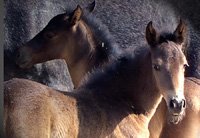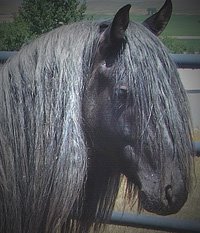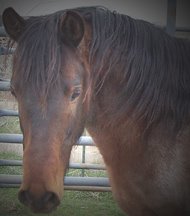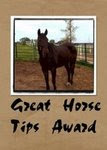
As you can see, Aaruba is tricked out with more doodads than he was wearing back in April. Let's go through the items, head to hoof.
Dr. Cook's Bitless Bridle: Despite his obnoxiously sales-pitchy website, Dr. Cook has designed a bridle that continues to work well for Aaruba. The beta shows no sign of wear despite many hours of exposure to sweat and sun, and once you become accustomed to the bridle's unusual configuration of straps, it's quite easy to use. When I catch Aaruba up for a ride, I usually bridle him straight away instead of haltering him first for grooming; that way, I can simply tighten the noseband and mount up without having to change his headgear.
The Bitless Bridle seems to give Aaruba clear signals both laterally (for turning/bending) and vertically (for stopping/collecting). I particularly like how it is designed to put pressure on his poll when I tighten both reins, as he is prone to high-headed nervousness and I have trained him to lower his head in response to poll pressure. Unfortunately, the straps that cross beneath Aaruba's jaw sometimes rub a bit when I have to hold him in for long periods, such as when he wants to rush during a race. However, this is more a training problem (we're working on it) than a tack problem, and at its worst, it's by no means severe; it may rub off some hair, but it's never broken the skin.
A definite downside to the Bitless Bridle is that it relies on a very tight noseband for maximum effectiveness. Tighter than a typical, English cavesson, the noseband doesn't interfere with Aaruba's breathing, but it does limit his ability to chew -- obviously less than ideal for an endurance situation, where a little trail side grazing is desirable. The good news is that after fifteen miles or so, Aaruba generally settles down enough that I can loosen the noseband a notch, sacrificing a bit of control in favor of his comfort and ability to eat.
Cotton Rope Rein: This is the second 8-foot, cotton rope rein I've purchased from my local tack shop; the first one needed replaced after a couple hundred miles, when the splice pulled out on one side and the rein came loose of the clip. I prefer a loop rein to split reins because I typically ride with very light hands and I don't want to risk losing a rein if it slips from my grip. The soft, lightweight, round rope is comfortable most of the time, but I need to buy some summer weight riding gloves because the rope has been known to rub my knuckles raw in tight-rein situations.
Lead Rope: I like to keep a lead rope clipped to a side ring on Aaruba's bridle so I can dismount and lead him with something other than the reins. I've had this 6-foot lead since I was a kid. Its snap is one you'd normally see on a dog's leash rather than a lead rope, and the round nylon rope is only a half-inch in diameter. This makes for a lightweight combination that doesn't tug on Aaruba's face. While riding, I keep it looped around my saddle's pommel in such a fashion that it won't loosen with Aaruba's movement, but it will pull free if he or I tangle in it.
Breastcollar: This is a standard, nylon breastcollar in the Y-style that won't restrict Aaruba's breathing. Though I've had no trouble with rubs, I'd still like to find some fleece covers for it. Where do they sell those things, anyway?
Snugpax Pommel Bags: I chose the Slimline Western Deluxe style because it offers two water bottle holders, a small pocket ideal for my rider card, and two pockets large enough for such items as a lightweight jacket or camera. The bag is of good quality, its fleece backing seems comfortable for Aaruba, and its attachment straps work well with my Stonewall saddle.
However, the lower pair of attachment straps that are made to be tied on are slippery and sometimes come untied, even when double- or triple-knotted. This leads to either wasted time during a race, or several awkward moments of attempting to guide an excitable horse while posting and leaning over to re-tie straps in the region of my knee -- not my favorite activity. I'm considering tying on some kind of clip that can then be snapped to the saddle rigging in an attempt to alleviate this problem.
I'm also considering switching to cantle bags because my loop reins tend to get caught on the pommel bags, which is annoying at best and potentially dangerous at worst. This is the reason I only bring the bags along for rides of 15 miles or more; otherwise, I'll go without water just so I don't have to deal with snagged reins. The good news is that my sponsorship saddle from Stonewall will come with rear-mounted water bottle holders similar to those you'd use on a bicycle, so I'll be able to carry water on every ride without any hassle.
Stonewall Lightweight Endurance Saddle: Back in April, I was concerned that Aaruba's head-tossing behavior was related to improper saddle fit. I'm happy to report, however, that we've long-since resolved the behavior issue, and the saddle had nothing to do with it...thank goodness, because I love all 12 pounds of this saddle, from its centerfire rigging that reduces probability of girth rubs to its deep, comfortable seat and minimalist design.5-Star Wool Saddle Pad: After 600 miles and many washes, this wool felt pad is just starting to show its age. That's just as well, because although I've appreciated its contoured design and quality, its 1-inch thickness is less than ideal for use with my saddle. Stonewall Saddle Company recommends a 3/8 inch, wool pad and offers one designed specifically for their saddles, so I'll be switching to Stonewall pads shortly. It'll also be nice to reduce the surface area of Aaruba's back that is covered by the pad, particularly during summer weather when his ability to radiate heat is critical.
Incidentally, Jackie Fenaroli at Stonewall informs me that a 1-inch change in pad thickness changes the pitch of the saddle from front to back by 1 degree. This is because a saddle pad lifts the saddle more near the horse's shoulder than near his loin; the thicker the pad, the steeper the angle from pommel to cantle. An endurance rider might increase his horse's comfort during a long ride by adding or removing a thin pad at the midway point, thereby slightly altering the pressure on the horse's back.
Cool Tack Western/Endurance Seat Cover: This merino wool seat cover fits nicely on my Stonewall and has certainly contributed to my comfort over the miles. Not only is it cushy, but it adds a bit of friction between my seat and the saddle's, which comes in handy during those dramatic Arab-style spooks. A word of caution about wool seat pads, though: I hear that they can absorb a tremendous amount of water during a rainstorm. I haven't had opportunity to experience this issue personally, but I imagine it would render the seat cover very uncomfortable, not to mention heavy!
Neoprene cinch: If I had a better memory, I'd tell you what brand my cinch is. Instead, I'll tell you that I appreciate its generous width (5 inches) and roller on the near-side buckle, which eliminates bunching problems while cinching up. Its also nice to simply hose the cinch off after a sweaty ride.
E-Z Ride Stirrups: I use the caged, nylon style. Padded, shock-absorbent, and 4 inches wide, these stirrups are worth every strange look I get from passing cowboys. Call me a coward, but I relish the security of the cages that allows me to rest my foot deep in the stirrup without fear of slipping through. Over many miles of posting, the bottoms of my feet sometimes grow numb, possibly because I am in denial regarding my need for bunion surgery. The easy fix is to hop off and jog a hundred yards or so, which I'm sure feels nice to Aaruba as well.
Interference boots: I introduced Aaruba's interference boots in this post, when they were brand new. I've been using them ever since and sure enough, they've eliminated the interference injuries and seem to be holding up well. Last Sunday, though, the off front interference boot joined forces with an Easyboot gaiter to rub the inside of Aaruba's fetlock. I think the bottom edge of the interference boot slipped under the gaiter, so a minor adjustment will likely prevent that particular rub from recurring.
Easyboot Bares: If you've been reading The Barb Wire blog for long, you know I'm committed to keeping Aaruba barefoot if at all possible. His feet are in very good condition and perfectly capable of going long distances without protection, as he proved on Day 2 of the Pink Flamingo Classic. However, most of our training miles are run on the gravel shoulders of paved roads, so boots are necessary to prevent over-wearing of his hoof walls.
Thus far, I've been happy with the Bares, particularly since they loosen up after a few rides and become much easier to put on. I do have my eye on the new Renegade Hoof Boots, which are reportedly very easy to use, but at $169 per pair, they're more than twice the price of the Bares in EasyCare's bargain bin (they come with the old-style gaiter but are otherwise up-to-date). I've lost one boot at each of our two competitions thus far in 2008, so keeping costs down is a good thing. On the other hand, I've not lost a single Bare during hours upon hours of conditioning, and not until last Sunday's ride did Aaruba finally wear one through at the toe.
Gaiter rubs are an occasional problem with the Bares. I've had better luck fastening the gaiters more loosely than recommended by EasyCare, but rubs do sometimes occur on long rides, particularly on Aaruba's forelegs. I suppose the Renegades would eliminate that issue...but mightn't they cause rubs elsewhere?
That's it for Aaruba's tack. Most of my own gear is a bit lower-tech; for example, my riding tights are from the "activewear" section at Target, and this time of year, I've sacrificed fashion to the comfort of a loose-fitting, 3/4 sleeve, cotton blouse. My watch, left over from my distance running days, has a handy "chrono" feature that enables me to track both segmented and overall times during a ride. On rare occasions that I have cash leftover after purchasing tack for Aaruba, I have picked up a few goodies for myself.
Ariat Terrain Riding Boots: Quite popular among endurance riders, these are hands-down the most comfortable boots I've ever purchased. I wear them every evening and all day on weekends, for everything from groundwork and riding to feeding and fence repair.
Half Chaps: Aside from a semi-defective zipper on one chap, I've been very pleased with the fit, comfort, and quality of the Just Chaps, Ltd. half chaps available from Running Bear.
Tipperary Sportage Helmet: I've said it before...If I'm going to ride a 900-pound prey animal at high speeds through unfamiliar terrain, the least I can do is put an extra layer of padding between my brain and the nearest boulder.
'Nuff said.
_____________________________________
Related Posts
The Fitting Room: Endurance Tack
The Stocking Trick (Or, Aaruba Dresses in Drag)
Tack Test: Indian Bosal
New Duds: Interference Boots for a Barefoot Endurance Horse
Upward in the Night
_____________________________________
Want to read more posts like this one? We deliver!









5 comments:
Tamara,
I've been using the Renegades for the past year with vey good success overall...feel free to contact me if you've got questions about them, I'd be happy to provide more details.
I used to use Bares and had a lot of gaiter rubbing issues, and I haven't had that problem with the Renegades.
I can attest to the fact that sheepskin covers absorb water! They definitely get soggy, but the wool actually stays fairly warm.
Been following up your tips.
Those Ariat boots look like I could just about do roadwork in them, too.
Thanks for the recommendations!
sj
Aruba looks fantastic! Thats a great shot of you two.
Love the run down on the equipment. I'll be sure to point folks here who have questions on the hoof boots ;)
I *love* my Ariat Terrain paddock boots! They are actually my fulltime shoes anymore because I have a really bad ankle and I can lace them up tight for support. I always hate when winter gets here and I have to switch to snow boots. I am only just starting to use Renegades on my horse and I love how easy they are to get on and off. Carmon
Post a Comment